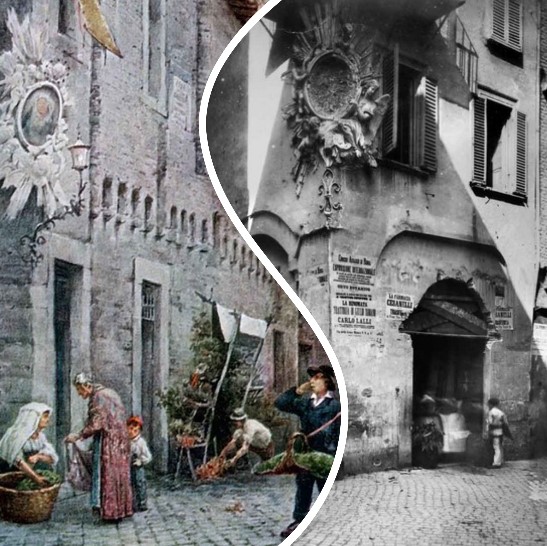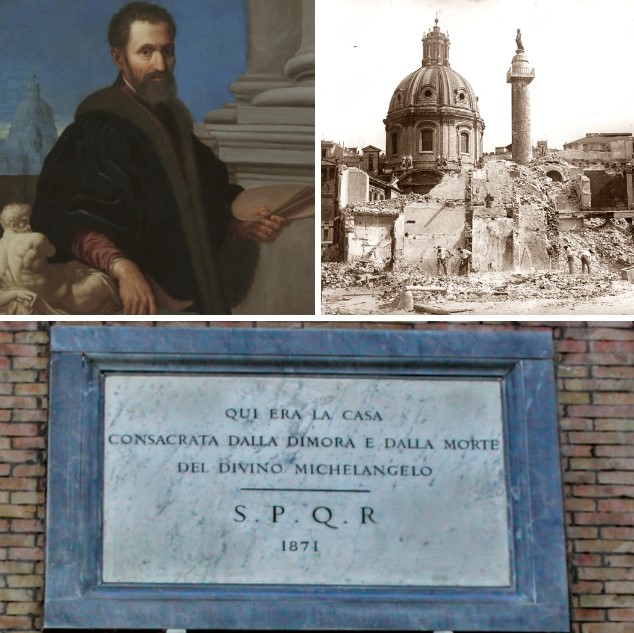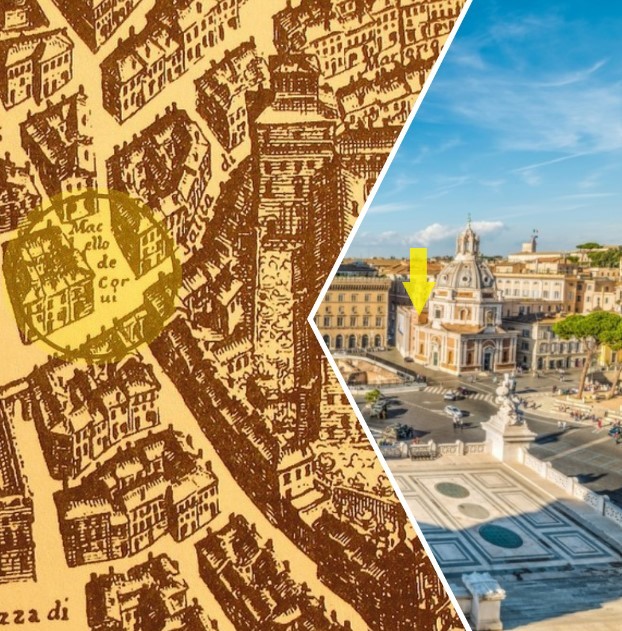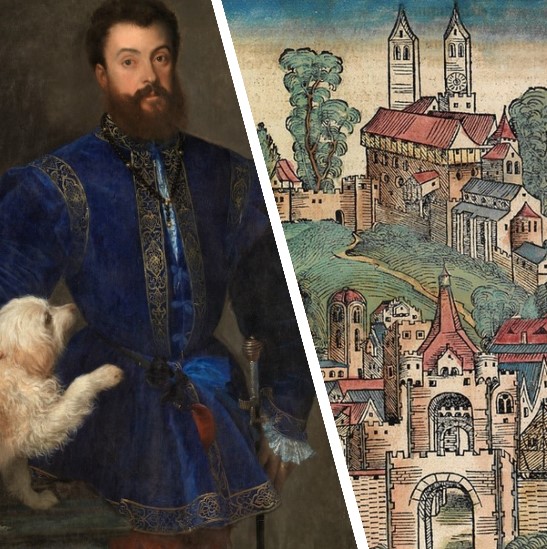Giulio Romano: Raphael's Heir
Rome, Italy
Giulio Pippi (1492-1546), known as Giulio Romano, was the most talented pupil of Raphael. He was born in Rome to Piero Pippi de’ Januzzi, in the house located on one side of the street known as 'Macel de' Corvi' (at the corner of Via di Marforio). It was just a stone's throw from the Roman Forum and the Capitoline Hill, in an area characterized by small, medieval-era common dwellings, where the air was neither salubrious nor fragrant, due to the large open-air public latrine present there. It was also where butchers dumped their waste, hence the toponym 'Macello dei corvi' (the murder of crows).

Pippi's home on Macel de' Corvi.
From 1513 onwards, Michelangelo Buonarroti also lived here; a modest man who did not enjoy living in luxury and opulence. And this was not because, as was said, he was stingy. In fact, he agreed to work on the construction of St. Peter's Basilica as a form of penance for his sins without accepting any payment, unlike his colleagues Raphael, Antonio da Sangallo, and Peruzzi. He lived there for several years because the heirs of Pope Julius II della Rovere had given him that house so that he could complete the monumental tomb of their beloved [Pope], destined for the (then under construction) tribune of St. Peter's Basilica.

Michelangelo's home on Macel de' Corvi demolished in the 19th century during the construction of the Vittoriano in Piazza Venezia; it was located to its right.
Michelangelo's house was located in Macel de’ Corvi, on a corner of what is now Piazza Venezia, in a recess right at the entrance to the Imperial Fora, near the ruins of Trajan's Forum. All that remains to commemorate his dwelling, which was full of cats, chickens, and marble chips, are a couple of plaques on the palace next to Trajan's Column, which often go unnoticed:
Here stood the house consecrated by the dwelling and death of the divine Michelangelo.
Around 1902, the area was demolished to make way for the expansion of Piazza Venezia and the construction of the Vittoriano monument, and the two aforementioned streets disappeared.

Location of 'Macel de' Corvi' near Piazza Venezia
Little is known of his childhood, except that his father worked diligently to ensure Giulio devoted himself to the study of drawing from a young age. These efforts were rewarded, as his son distinguished himself through his skill and became a disciple of the master from Urbino (Raphael).
It should be noted that Pope Julius II summoned Raphael Sanzio from Urbino to Rome in 1508, when the artist was already famous for his excellence in the art of painting. Faced with the many works he had to execute, Raphael had two options: either collaborate with excellent, already-established artists, or educate very young, gifted pupils and thus create his own school. The former option came with problems, as established artists had their own working methods, making it difficult to mold them to his needs; the latter involved talented children who had everything to learn.
Giulio was one of the first disciples of this school. The art historian Vasari recounts that he was beloved by Raphael, who took him in to live with him and raised him like a son.
At sixteen, his father died, and he and his sister were left orphaned and alone. His friend Lorenzetto Penni fell in love with his sister, and they had five children. Raphael did everything he could to ensure their marriage was celebrated, but it did not take place until after the master's death.
Lorenzetto was the son of a poor Florentine bell-maker. He moved to Rome at a very young age to learn his art, becoming a disciple of Raphael, who was very fond of him, and eventually a famous sculptor and architect.
Pippi was always exceedingly gentle in conversation, jovial, affable with everyone, of excellent manners, and of a graceful and pleasing appearance. He was ever studious and eager to learn perfection from the ancient models of Greco-Roman art.
In a short time, Giulio distinguished himself among his companions within Raphael's crowded workshop, specializing in painting and architecture. Sanzio held him in very high esteem and established an uncommon agreement with the disciple: Giulio would create the initial design, make the preliminary sketches, and the master would apply the final touches. Out of respect for the copies of original paintings made by the students, the final retouching was done by either Giulio or Raphael himself.
Giulio rapidly became first an expert in architecture and then an most excellent master.

Villa Lante, Palazzo Alberini, Palazzo Cenci-Maccarani, and Villa Madama.
He collaborated with the master on his great undertakings. Indeed, Raphael delegated important tasks to him, confident in his qualities, and some works were followed indiscriminately by one or the other. Some examples include:
• The elegant Villa Madama (Via Villa Madama, 250), built outside Rome's historic center on Monte Mario, on the right bank of the Tiber.
• Palazzo Alberini (Via del Banco di Santo Spirito 12), Pippi's finest achievement in Rome. It was commissioned by Giulio of the Roman Alberini (or Ilperini) family between 1515 and 1519, designed by Raphael, although Vasari states it was Giulio Romano who designed the palace for him. The ground floor is attributed to Bramante, with a possible date of 1512. It was completed in 1521 by Pietro Rosselli.
• Palazzo Cenci-Maccarani (finished in 1549) in Piazza Sant’Eustachio is the last building designed, though only partially realized, by Giulio Romano before he left for the Gonzaga court in Mantua, where, starting in 1524, he would create the Palazzo Te.
• Villa Lante, built between 1518 and 1531 by Giulio Romano for the Tuscan Baldassarre Turini, an important official in the courts of the Medici popes, Leo X and Clement VII. The artist succeeded in making it another enchanting place, both for its magnificent view of the city and for the ornamental garden that surrounded it. The duration of the work was prolonged due to the Sack of Rome in 1527 by the Landsknechts. The interior decorations are also by Giulio Romano and assistants from Raphael's school.
Giulio Romano's originality compared to other architects of the time was his ability to allocate part of a residential building for commercial use without causing it to lose prestige.
Upon Raphael's premature death in 1520, Giulio inherited his workshop and ongoing commissions by will, along with his colleague Giovan Francesco Penni, with whom he collaborated for a long time. He thus found himself completing works already begun with the master, such as Villa Lante, Palazzo Cenci-Maccarani, and Villa Madama.

Mantua in 1493 and Portrait of Federico II Gonzaga by Titian in around 1529 (Museo del Prado, Madrid)
In 1521, Pope Leo X (born Giovanni di Lorenzo de' Medici), a patron of many artists, died. He was succeeded by Adrian VI of Flemish origin. Vasari recounted that this pontiff was not very inclined towards art and that the excellent artists who had flocked to Rome, which previously offered much work, nearly starved under him. After a pontificate of almost twenty months, he died and was succeeded by the Medici cardinal, who took the name Clement VII. His first command was that the projects interrupted by the death of Leo X be resumed with renewed vigor; and Raphael's heirs returned to work at full pace to complete their master's unfinished projects.
When all these works were completed and the terms of Raphael's will were satisfied, the heirs decided to separate. The cause of this division was not envy, jealousy, or anything else.
Having parted ways with Penni, Giulio opened a public school in his own home, which was attended by those disciples who had not yet completed their study of art due to Raphael's death, as well as others who were trained entirely by Pippi.
Giulio had also inherited the friendship of some illustrious figures, whom his master had considered more as friends than patrons; among them was Baldassarre Castiglione, the charge d'affaires to the Pope from the Marquis Federico Gonzaga of Mantua.
Castiglione, aware of his lord's desire to execute grand embellishment projects in the Lombard city, and having seen the work completed at the Vatican by Giulio Romano, persuaded him to follow him to Mantua.
In 1524, after completing the works left unfinished by Raphael and after much insistence, he accepted the invitation and moved, despite the prestigious career he had begun in Rome. Thus, this city became his second homeland, where he acquired citizenship.
Two years later, he was honored with the complete confidence of the prince, receiving the title of superintendent of buildings and "superior of the urban roads." These two positions allowed him to oversee all the court's architectures and artistic productions, enabling him to carry out a vast body of work as a painter and architect. His work was marked by decorative splendor and a taste for wonder and ingenious, bizarre artifice, which became widely influential in the Mannerist culture of European courts. Together with some of his pupils, he entirely modernized the city, restoring and decorating ancient buildings, constructing new ones, and finally protecting the country from the floods of the Po and Mincio rivers by means of embankments and wise planning, while also reclaiming the many surrounding marshes. Cardinal Gonzaga used to say that Mantua was created by Giulio, and that it belonged to Giulio.
It was then, in 1526, that Penni left Rome to follow Giulio Romano to the Gonzaga court. According to Vasari, Penni was not received very warmly in Mantua and, a few months later, preferred to leave Romano to undertake a long journey through Lombardy, subsequently returning to Rome, and finally going to Naples (1526), where he worked in the service of the Marquis of Vasto and where he died in 1528.
In 1529, Giulio married the Mantuan noblewoman Elena Guazzo Landi in Mantua. They had two daughters and a son, whom they named Raffaello in honor of his master from Urbino.
When Vasari visited him in 1541, he found a rich and powerful man. His status allowed him to build a palace for himself in the center of Mantua, known today as the Casa di Giulio Romano (Giulio Romano's House).
However, the death in Rome of the architect of St. Peter's, Antonio da Sangallo the Younger, awakened in Giulio the desire to return to his true homeland to become the head architect of the Fabbrica di San Pietro. The Romans, for their part, fully aware of his merit, pressured the Pontiff to appoint him as Sangallo's worthy successor.
Yet, his family and friends, seeing his poor health, advised and discouraged him so strongly that he repeatedly postponed his departure. In a weakened state, he fell ill and died in 1546 at the age of fifty-four. He was buried in the church of San Barnaba in Mantua. His tomb was desecrated and lost during a renovation completed in 1737.
22 Piazza della Madonna di Loreto (Rome)
